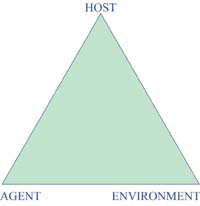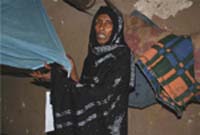3.4.2 The communicable disease model
The communicable disease model presents three elements; infectious agent, host and environment, as the minimal requirements for the presence and spread of a communicable disease in a population.
The infectious agent is the element that must be present for the disease to occur and spread. Bacteria, viruses and parasites are examples of infectious agents.
The host is any susceptible organism. Plants, animals or humans can be invaded by the infectious agent and become the host.
The environment includes all other factors that either promote or prohibit disease transmission.
Communicable disease transmission occurs when a susceptible host and an infectious agent exist in an environment that allows disease transmission.

According to the communicable disease model, the role of health education and health promotion in reducing the occurrence and transmission of diseases can be brought about by specific actions.
Think of tuberculosis (TB), malaria and intestinal infections as examples, and then answer the following questions:
- Note one way to reduce the susceptibility of hosts.
- Note one way to destroy infectious agents.
- Note one way to reduce the contact between the host and the agent.
- Note one way to modify the environment so that it is not conducive for disease transmission.
You may have answered with the following examples:
- Good nutrition will build a person’s defences against infection and reduce their risk of developing TB.
- Cooking food properly destroys infectious agents that could cause intestinal infections.
- Wearing a mask or holding your hand in front of your mouth while coughing will reduce the contact between the agent that causes TB, and other human beings. Using a bed net will reduce contact with malaria — carrying mosquitoes (Figure 3.6).
- Drying swampy and marshy areas will make the environment less easy for mosquitoes to breed in and therefore reduce the incidence of malaria.

3.4.1 The chain of infection model
